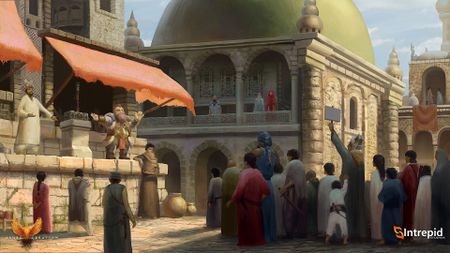Vassal nodes
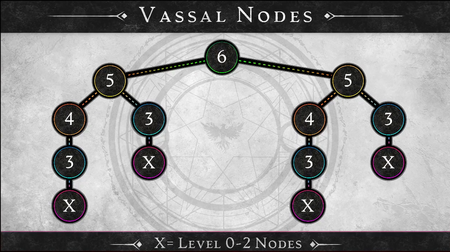
This vassal mode structure tells you what it looks like for a sovereign at a level six metropolis stage; and what it can control at a maximum vassal network is two level five nodes, of which a level five node can control one level four and one level three as direct vassals; and then the four can control a three; and every three can control a one or a two. Now if the three gets removed through siege, the one or the two is removed as well. So that's an important distinction between the three's vassals, which technically isn't really a vassal relationship because there's no citizenships possible. Those vassals don't exist between three and X, but they do exist between four and three, five and four, and six and five. And what this also allows is that because there are 85 nodes that are within the world, we have a buffer zone of about 20 nodes that lives in a max server state. So if you had maximum five metropolises form in a world, you will have a number about 20 nodes that can live alongside those metropolis networks; and when or if a metropolis falls, that extra cushion of nodes around the five metropolis structures allows for the map to be redistricted in a way that is unique. It doesn't mean that one of the fives is just going to pick up where the last six left off and form the same exact metropolis structure. From a territory perspective it has ancillary nodes to play with and expand towards that redistricts the map, so that if a metropolis falls there's a significant difference in the layout of the world and the layout of these almost nation-like territories.[1] – Steven Sharif
Village (stage 3) or higher nodes enslave nearby nodes, converting them into vassal nodes.[2][3]
- A Metropolis (stage 6) can control up to two City (stage 5) nodes. A City (stage 5) can control one Town (stage 4) and one Village (stage 3) node. A Village (stage 3) can control an Encampment (stage 2) or an Expedition (stage 1). If the Village (stage 3) gets destroyed through a siege, its dependant Encampment (stage 2) and Expedition (stage 1) nodes are also destroyed.[1]
- There is a layer of intricacy between how the neighboring nodes advance and what potential parent structure they have in the vassalship tree.[4] – Steven Sharif
- Vassal nodes gain benefits from their regent node (also referred to as sovereign node or parent node) even if the node type of the parent is different to the vassal.[5][6]
- It is not a bad thing to be vasseled, it is a good thing to be vasseled. It brings many benefits from the Sovereign, which is the ultimate parent of that vassal network down to the vassal node itself; and it allows that vassal node to even live outside of its normal mechanics. You get to adopt some of the benefits that the node type of your sovereign is, even if your node type as a vassal node isn't the same.[6] – Steven Sharif
- Regent nodes collect taxes from their vassal nodes. These taxes cannot be taken by the mayor or other players.[8]
- Vassal nodes must remain at least one node stage below their parent node.[2]
- Neighboring/Adjacent nodes from Expedition (stage 1) upward block the growth of their immediate neighbors. This was intended to be tested in Alpha-1.[9][3]
- Vassal nodes first apply any experience earned to their own deficit (see Node atrophy). It then applies excess experience earned to its parent node.[10]
- If the parent node advances, the vassal is once again able to advance.[2]
- Vassal nodes give excess experience to their parent node and may have their own vassals; so long as they fall within the parent node’s zone of influence.[8][2]
- If a node is capped and is both a vassal and has its own vassals, any experience earned from itself or its Vassals is first applied to its own deficit. Experience beyond that is then sent to its parent node.[10]
- When the vassal reaches its cap it overflows experience up to the parent; and so it can be very good early on for parents to get vassal nodes that are very productive- that have a lot of traffic.[8] – Steven Sharif
- Vassals are subject to the government, alliances, wars, taxes, and trade of their parent node, and are able to receive federal aid from them.[2]
- Vassal nodes cannot declare war on their parent node or any of their vassals.[2]
- Citizens of vassals are bound by the diplomatic states of the parent node.[2]
- If a Node is a Vassal Node and is capped from advancing further, it first applies any experience earned to its own deficit (see Node Atrophy section), and then applies excess experience earned to its Parent Node. If the Parent Node advances and the Vassal is able to grow, it becomes uncapped. If a Node is capped and is both a Vassal and has its own Vassals, any experience earned from itself or its Vassals is first applied to their own deficit. Any experience beyond that is then sent to its Parent Node.[10] – Margaret Krohn
Adjacent/Neighboring nodes
Adjacent nodes (Neighboring nodes) starting from Expedition (stage 1) may block (lockout) the growth of their immediate neighbors.[9][3]
- Vassal nodes must remain at least one node stage below their parent node.[2]
- Encampment (stage 2) and Expedition (stage 1) nodes are technically not vassal nodes as they do not support citizenships. If their parent Village (stage 3) node is destroyed by a node siege, these nodes are also destroyed.[1]
Node advancement
Citizen and non-citizen player activity (questing, gathering, raiding, etc.) within a node's ZOI counts toward that particular node's advancement (progression) to a higher node stage.[10][12]
The advancement of a node unlocks its unique content, which comes at the cost of locking out an increasing ring of neighboring nodes from progressing to the next stage.[13]
- Nodes advance to the first stage quickly. This enables NPC services such as vending or banking items.[14]
- The more advanced the node is, the larger its ZOI becomes.[15]
- Less advanced nodes (referred to as vassal nodes) that fall within a more advanced node's ZOI can still gain XP, but must remain at a lower advancement stage than the dominant node.[16]
- The vassal system begins when a node hits Village (stage 3), but neighboring nodes starting from Expedition (stage 1) also block the growth of their immediate neighbors.[9][3]
- Certain quests, such as story arcs, may not be able to be turned in after a node has advanced.[17]
- The territory expansion algorithm takes into account the nearest coast, neighboring nodes, and the heatmap of players in surrounding areas over the last weeks or month.[18]
- Due to the way the progression algorithm calculates territorial (ZOI) expansion during node advancement, there is a small possibility that two nodes of the same stage end up being close to each other.[19]
- The way that the algorithm expands the territories takes into account a few things: One it takes into account the coast like where's the closest coast. Two it takes into account the neighboring nodes so it can take over and essentially vassal state those nodes, but what's more important is essentially the initial population based on like how players choose their races. Because we have nine different races and four different starting points that branch out, each server's population density is going to dictate essentially the first few nodes that are highly populated and then that initial seed is what's going to determine the node structure as it moves inland into the into the world essentially; and based on the performance and successes of different sieges will determine which nodes that got locked out from the previous the initial advancements what nodes can now be available to advance further. So I really think that with so many variables that are present in the equation of how nodes advance and stay existing with the more variables you have, the higher likelihood there is for there to be a significant diversion in world progression.[18] – Steven Sharif
- Normally the algorithm that's applied to the node territorial expansion will prevent significant nodes from being in close proximity to each other... There could be a perfect storm where all of the algorithmic progression of territory leads to having these nodes very close to each other because there's certain requirements that should that need to be available to satisfy node vassal takeovers; and it's possible that two nodes would never take each other over as vassals and end up close together and spanning their territories in opposite directions: The Tale of Two Cities thing.[19] – Steven Sharif
- A node does not receive XP from the nodes within its ZOI until these nodes have reached their cap.[16]
- Node experience gain opportunities will be equitable across the four node types.[21]
- Different people have different resources invested in nodes progressing and it would be a little "gamey" if you could know exactly what was necessary at that point because that would disincentivize people from participating.[22] – Steven Sharif
Node advancement spawns a series of animations and visual effects (within the footprint of the node).[23][10]
- Players within the node are teleported to a safe location, likely a respawn area near the node.[23][24]
- Supplies will spawn around the node and system driven caravans are spawned to bring these supplies into the node. These caravans are not able to be attacked.[23]
- NPCs will begin construction activities.[23]
- Players outside the node will see the new facade of the node pop into existence as the node advances in stage.[23]
- The Development Area of a Node is where civilization will appear as the Node advances. As the Node Stage increases, different buildings, NPCs, and services will become available in the Development Area. The higher the Node Stage, the more complex and populated the Development Area becomes. Development Areas will also vary depending on the Node Type - Economic, Military, Scientific, or Divine.[10] – Margaret Krohn
Taxation
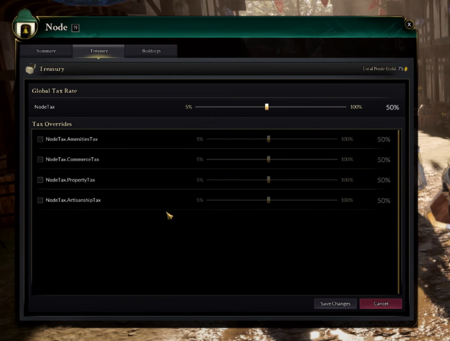
As the node levels up, you're gonna get access to deeper controls on the taxes, so that you as a Mayor can incentivize players to come to your node to do certain things. If you're a node that loves smithing, you're probably going to want to lower your taxes on artisanship to incentivize players to be here. But then you might want to drive up taxes on other avenues that players aren't necessarily coming to your node for, but are using out of convenience.[25] – Chris Justo
Mayors are able to set a generalized node tax rate as well as overrides for different activities within their node. Mayors gain additional taxation controls as their node advances.[25][26]
- Amenities tax override.[25]
- Artisanship tax override.[25]
- Commerce tax override.[25]
- This may include taxes that apply to tavern games.[27][28]
- Property tax override.[25]
- Freehold property taxes scale according to the number of freehold building permits issued for that freehold.[29][30][31]
- Citizenship dues and property taxes scale based on the stage of the node when a player became a citizen.[32][33][34][35][36]
- The goal is to exert financial pressure on node populations by making taxes increasingly expensive as nodes advance, rather than putting in place hard population caps.[34][35]
- Node tax rates will be visible on the world map by hovering over a node location.[37]
- Tax revenue only goes toward funding node development. This cannot be withdrawn by the mayor or any other player.[8][31]
Regent nodes take a cut of taxes from various activities that occur within their vassal node structure.[8][38]
- This tax doesn't necessarily impact the individual citizen, because citizen's tax levels are determined by their node, but the node's finances are affected by the taxation levied by its parent nodes.[38]
Node atrophy
Nodes accumulate an experience deficit each day based on the node's level, called node atrophy. The deficit is subtracted from any experience earned that day. If any deficit remains, then this is subtracted from the node’s experience pool.[10]
- An atrophy system may be implemented, where accumulated atrophy points will progressively disable services within a node. The node may be destroyed if a significant points threshold is reached.[19]
- There are intrinsic problems with reducing a nodes level as opposed to removing the node and it may be possible I'm just gonna say now that we don't actually atrophy nodes to delevel but rather accrue atrophy points that must be replenished over time; and if not it begins to disable services and further compound the atrophy problem; at which point when it reaches a certain atrophy point then the node would just disappear.[19] – Steven Sharif
World manager
The World manager is an algorithm in Ashes of Creation that controls dynamic world elements. It acts as both a throttle and an incentive system for various activities to ensure certain parameters are within acceptable thresholds.[39]
- A world manager is a technical term to define a server process that lives alongside the game server; and when the game server needs to do things- communicating with other game servers within that grid- it tells that manager and that manager sends it down to the appropriate server.[40] – Steven Sharif
- Prices of glint.[41]
- A heatmap of experience being gained to apply to node advancement.[41]
- The territory expansion algorithm takes into account the nearest coast, neighboring nodes, and the heatmap of players in surrounding areas over the last weeks or month.[18]
- Due to the way the progression algorithm calculates territorial (ZOI) expansion during node advancement, there is a small possibility that two nodes of the same stage end up being close to each other.[19]
- Transit of resources and goods between regions to drive quest rewards for nodes.[41]
- For example if you know iron is being used as a raw resource for a specific crafting path that might drive up the price of mithril or silver; and that will incentivize the market to course correct a little bit. The idea is to provide soft incentives that help to alleviate the demand and also to prop up the supply that might not be present from the economic systems.[41] – Steven Sharif
Auction houses
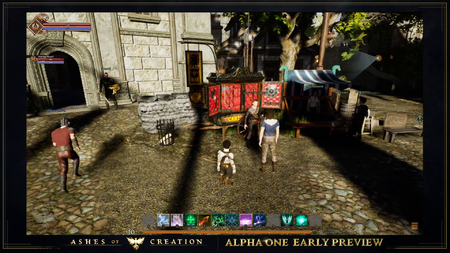
If a Node is the Vassal Node of an Economic Node, an Auctioneer NPC appears in that Vassal Node. The Auctioneer allows players to list non-resource/processed materials in the Parent Node’s Auction House, but players cannot bid on items from this Auctioneer. These resources and processed materials must be stored within an Economic Node in order to be listed in that Node’s Auction House. In order to bid, they must still travel to the Auction House in the Parent Node.[43]
Auction houses enable players to list items at specific nodes.[44][45]
- Previously this was stated to be at the economic node in which the auction house is located. The new quote may not necessarily contradict this statement.[46]
- Auction houses allow items and resources to be listed for sale at a specific node location.[44] – Steven Sharif
- A listing fee will be charged to list items in the auction house.[46]
- Vassal nodes of the auction house node will be able to view items that are listed on that auction house, regardless of node type of the vassal node.[46]
- Items listed are also visible in community boards (bulletin boards).[47]
- Integrated auction houses allow players to purchase items directly from remote auction houses.[47]
- Purchases of materials and gatherables will be automatically deposited within the listing node's local warehouse. Players will need to travel to that warehouse to retrieve them. Players wishing to move these items elsewhere will need to utilize the caravan system or other type of transportation.[48][46]
- Purchases of anything other than materials and gatherables will be mailed to the purchaser.[48]
- There may be a taxation difference between auction houses versus other player businesses.[46]
- On a regular cadence, a number of a node's freehold parcels become available to be bid for at auction.[49]
- Data relating to auction houses, such as price history, volumes, average prices, may be available to players via a mayor-constructed service building in their node.[50]
- That's probably how it's going to be surfaced... Your your mayor is going to have to build it for you.[50] – Jeffrey Bard
Auction house locations
Auction houses accompany unique node buildings in Economic nodes.[43]
- Markets in Village level economic nodes have auction houses that allow raw resources and crafting materials to be posted.[43]
- Exchanges in Town nodes have expanded auction houses that allow all goods/items to be posted.[43]
- Economic nodes that have reached the metropolis stage unlock the linked economy superpower.[43]
- Up to two economic metropolises may be linked in this manner.[52]
- Metropolis level economic nodes enable worldwide sale prices for auction houses across Verra.[43]
- Items listed in one linked economic node can be bid on from any other linked economic node.[43]
- Linked economies also connect an economic metropolis and its vassal economic nodes.[47][43]
See also
References
- ↑ 1.0 1.1 1.2 1.3 Livestream, August 26, 2022 (1:07:34).
- ↑ 2.0 2.1 2.2 2.3 2.4 2.5 2.6 2.7 Blog - Know Your Nodes - The Basics.
- ↑ 3.0 3.1 3.2 3.3

- ↑

- ↑ Livestream, August 31, 2023 (52:56).
- ↑ 6.0 6.1 Livestream, August 26, 2022 (1:04:35).
- ↑

- ↑ 8.0 8.1 8.2 8.3 8.4 Livestream, August 26, 2022 (1:10:16).
- ↑ 9.0 9.1 9.2

- ↑ 10.0 10.1 10.2 10.3 10.4 10.5 10.6 10.7 Blog - Know Your Nodes - Advance and Destroy.
- ↑ Video, February 29, 2024 (33:57).
- ↑ A reactive world - Nodes.
- ↑ Video, April 20, 2017 (0:02).
- ↑
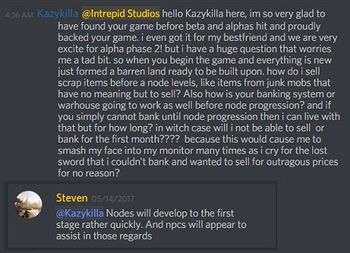
- ↑ Node series part II – the Metropolis.
- ↑ 16.0 16.1 Livestream, October 16, 2017 (50:20).
- ↑ Livestream, February 29, 2024 (53:58).
- ↑ 18.0 18.1 18.2 Interview, July 18, 2020 (10:04).
- ↑ 19.0 19.1 19.2 19.3 19.4 19.5 Interview, July 8, 2020 (1:00:15).
- ↑
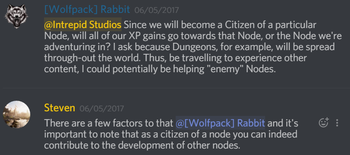
- ↑ Livestream, September 24, 2021 (1:21:23).
- ↑ 22.0 22.1 Livestream, May 26, 2017 (28:16).
- ↑ 23.0 23.1 23.2 23.3 23.4 Livestream, October 14, 2022 (55:13).
- ↑ Livestream, November 17, 2017 (55:27).
- ↑ 25.0 25.1 25.2 25.3 25.4 25.5 25.6 25.7 Video, August 31, 2023 (28:04).
- ↑ Livestream, March 28, 2020 (1:03:38).
- ↑

- ↑

- ↑ Interview, July 9, 2023 (54:46).
- ↑ Livestream, June 30, 2023 (1:45:22).
- ↑ 31.0 31.1

- ↑ Blog: Development Update with Village Node.
- ↑ Livestream, August 31, 2023 (15:51).
- ↑ 34.0 34.1 Interview, July 9, 2023 (38:14).
- ↑ 35.0 35.1 Interview, March 27, 2020 (0:30).
- ↑ Video, April 5, 2018 (41:48).
- ↑ Livestream, September 29, 2023 (1:11:22).
- ↑ 38.0 38.1 Interview, May 11, 2018 (57:02).
- ↑ Interview, July 19, 2020 (1:10:55).
- ↑ Livestream, October 14, 2022 (57:22).
- ↑ 41.0 41.1 41.2 41.3 Interview, July 19, 2020 (1:08:22).
- ↑ Livestream, March 28, 2020 (1:04:49).
- ↑ 43.0 43.1 43.2 43.3 43.4 43.5 43.6 43.7 Know Your Nodes: Economic Node Type.
- ↑ 44.0 44.1

- ↑ Unreal Engine Interview, 2017-05-23.
- ↑ 46.0 46.1 46.2 46.3 46.4 46.5 46.6 Livestream, May 30, 2019 (1:26:16).
- ↑ 47.0 47.1 47.2 Livestream, July 31, 2020 (1:34:06).
- ↑ 48.0 48.1

- ↑ Livestream, June 30, 2023 (1:13:53).
- ↑ 50.0 50.1 Livestream, March 26, 2021 (1:15:03).
- ↑ Ashes of Creation - The visuals.
- ↑



